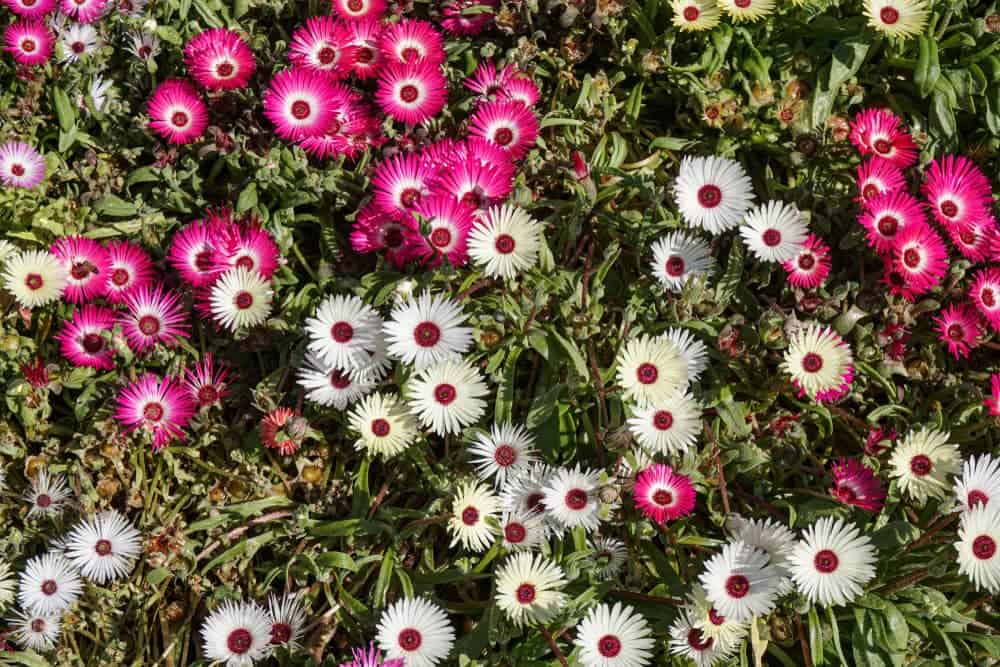Traditional grass lawns may look nice, but they can be a headache to maintain. Between mowing and watering, a lot goes into making grass look nice and neat.
Here are low-maintenance, sustainable, and water-wise alternatives: native ground cover plants!
These are low-growing plants that spread over an area, covering it in dense foliage. And since they’re native to Australia, they’re well-adapted to our local environment!
If you’re considering a non-traditional lawn, these plants are the perfect alternatives. We’ve put together this handy guide, as there’s a lot of ground to cover (ha!).
List of Australian Native Ground Cover Plants
- Australian daisy
- Blue flax lily
- Bower of Beauty
- Coastal rosemary
- Creeping boobialla
- Desert flame
- Grevillea
- Hardenbergia
- Mat rush
- Native violet
- Pig face
Ground Cover vs Grass

We’ll keep it simple: grasses are a type of ground cover, but not all ground covers are grass!
“Ground cover” is a catch-all term for plants that, well, cover the ground. The plant grows directly over the soil and provides benefits such as:
- Protecting the soil
- Retaining moisture
- Preventing erosion
- Improving appearance
Grass is the most commonly used ground cover, but it’s relatively high-maintenance and water-intensive.
Non-traditional lawn alternatives are becoming more popular, since they are more water-wise and low-maintenance. They’re also great for those who want no-mow lawns.
Why Choose Native Ground Cover Plants?
Aussie native plants make perfect ground cover alternatives to traditional grass lawns. They’re fully adapted to the local climate and environment.
Other advantages of native ground cover plants include:
- Minimal fertiliser needs
- Lower maintenance costs
- Drought and heat tolerance
- More sustainable landscaping
Many plants also provide food and shelter for native wildlife, which benefits local biodiversity!
There are some downsides, though. Lawn substitutes can appear patchy, especially if you grow seasonal plants that change throughout the year.
They may also spread more aggressively than grass or become more “wild”, especially in no-mow lawns. And they can be more expensive upfront, though they’ll cost less in the long run.
Native Ground Cover Plants for Australian Gardens
From cheerful daisies to chunky succulents, many native ground cover plants make ideal lawn substitutes. Here are some of our top picks for Australian gardens.
Australian daisy
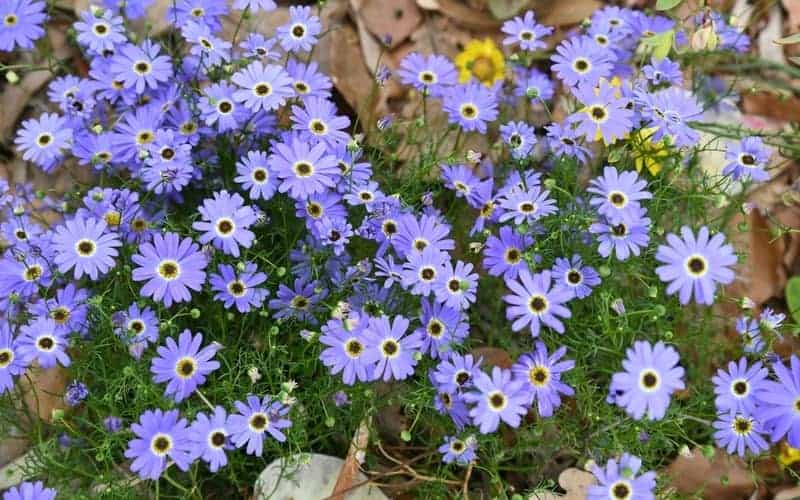
Height: Up to 0.5m
Flowering: Mostly spring
Tolerance: Drought, mild frost, poor soils
With about 1000 species of Australian Brachyscome daisies, it’s hard to pick a favourite!
These native daisies are perennials, so they will die back in the cooler seasons. They then come back in spring with colourful flowers, ranging from vivid white to cheerful purple.
Brachyscome plants have delicate foliage, so your Australian native daisy ground cover is best grown along borders or pavers. It tolerates most soil conditions so long as it has good drainage.
Blue flax lily

Height: Up to 1.2m
Flowering: Spring to summer
Tolerance: Drought, moderate frost, poor soils, salt, shade
Get some summer colour in your garden with some blue flax lily (Dianella longifolia)! You’ll love those rich blue-purple flowers that attract birds and beneficial insects.
This Australian native grass is also known as “blueberry lily,” thanks to its edible berries in the summer.
Blue flax lily is a tough, versatile flowering grass. It can grow in most climates except tropical, and tolerates a wide range of conditions so long as it has good drainage.
Don’t be afraid to cut back hard if the plant gets unruly — it’ll grow right back from underground rhizomes.
Bower of Beauty
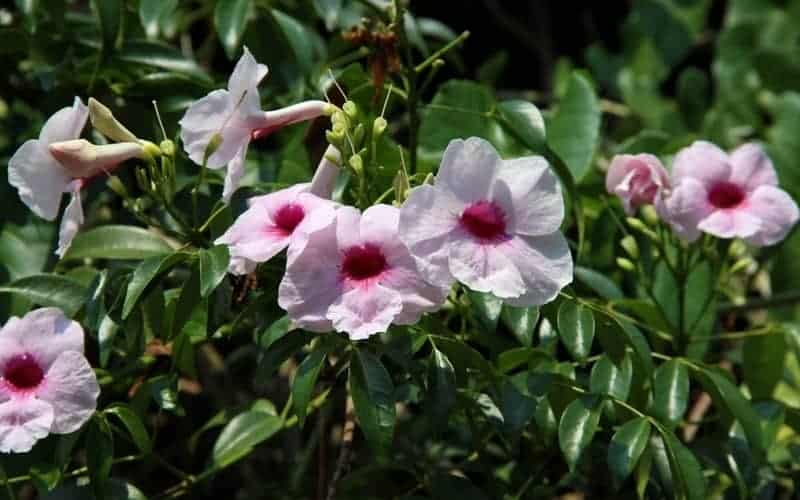
Height: Depends on pruning
Flowering: Late spring to summer
Tolerance: Drought, moderate frost, part shade, smog
While the Bower of Beauty vine (Pandorea jasminoides) is better known as a native climbing plant, it can also sprawl and ramble!
During the growing season, the plant puts out masses of pinkish-white flowers. They can last for weeks on the vine, but may be shorter-lived when grown on the ground.
Still, Bower vines are hardy plants — they’re drought-tolerant and can even grow in areas with smog.
Plant Pandorea jasminoides away from underground sewer systems, though, since it has a robust, penetrating root system.
NOTE: Another native climber that works as ground cover is Hibbertia scandens.
Coastal rosemary
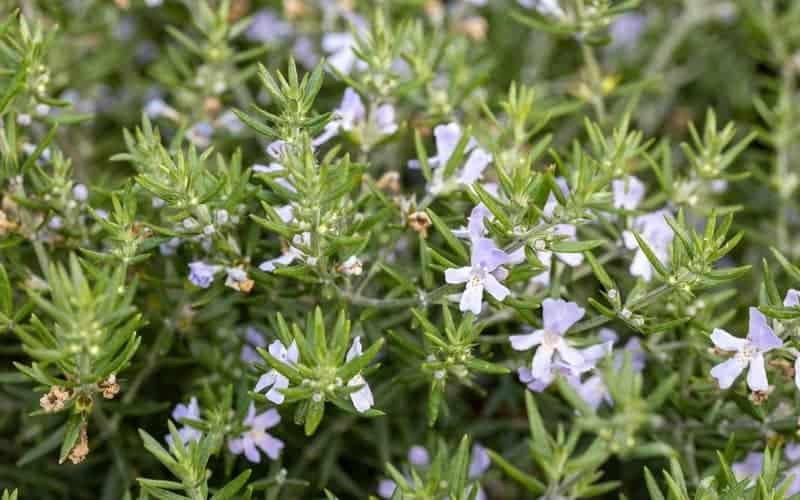
Height: Up to 0.3m
Flowering: Year-round, but mainly spring
Tolerance: Cold, drought, salt, moderate humidity, mild frost
Despite the name, coastal rosemary (Westringia fruticosa) isn’t related to the herb in your kitchen! It’s called rosemary due to its appearance — mainly the small, silvery-green leaves.
Throughout the year, the plant puts out small white blooms, peaking in November.
Westringia fruticosa grows along cliffs in the wild, so it thrives in coastal conditions and sandy or gritty soils. However, it can tolerate a wide range of soil types, including clay.
Coastal rosemary can become leggy or unruly, so prune it regularly.
TIP: Westringia fruticosa is excellent for underplanting trees such as ornamental pears!
Creeping boobialla
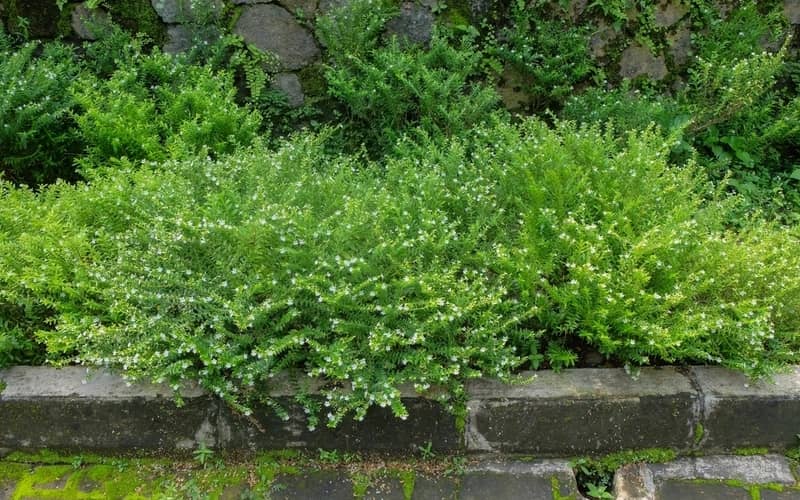
Height: Up to 0.3m
Flowering: Spring to autumn
Tolerance: Drought, mild frost, poor soils, salt
This creeping shrub is popular for its adaptability and pretty star-shaped flowers.
Creeping boobialla (Myoporum parvifolium) carpets your garden in fine, serrated foliage. In its growing season, you’ll get beautiful white flowers — or for some cultivars, pale pink!
The plant is hardy in many conditions, but thrives in full sun and acidic to neutral soil types. Avoid too-alkaline soils, though, and lower the soil pH level if needed.
Plant creeping boobialla if you need a fast-growing Australian native ground cover, as it spreads easily. This also makes it great for controlling or deterring weeds.
Desert flame
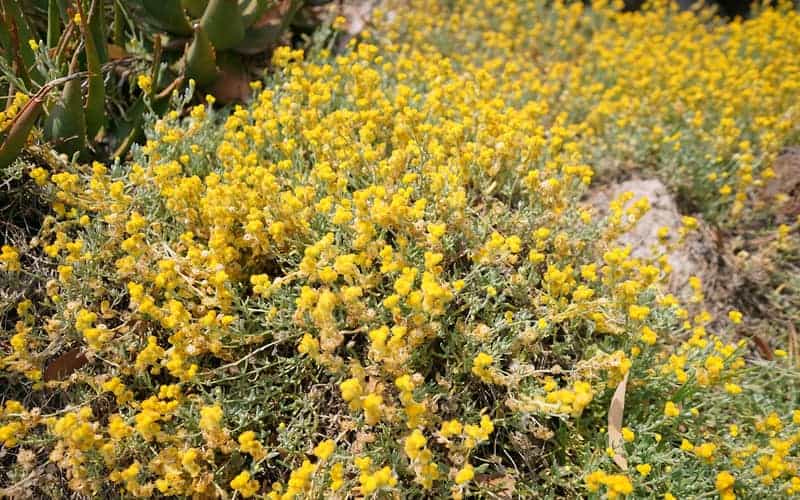
Height: Up to 0.3m
Flowering: Spring to autumn
Tolerance: Drought, mild frost, poor soils, salt
Add sunshine to your lawn with the bright yellow flowers of Desert flame plants!
Chrysocephalum apiculatum flowers almost year-round, with adorable, round blooms. In between flowering periods, this native ground cover boasts silver foliage.
This perennial herb tolerates a wide range of conditions, but thrives in temperate climates and lots of sun. Be mindful during blooming season, as Desert flame may be susceptible to caterpillars!
Grevillea
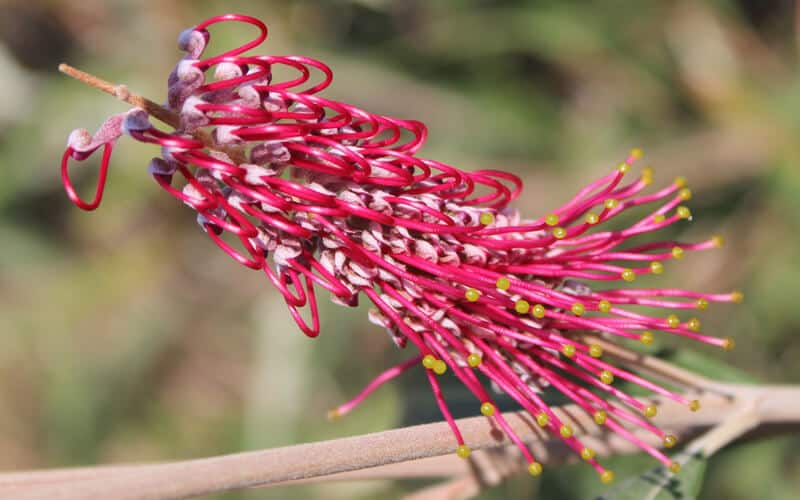
Height: Typically up to 0.5m
Flowering: Usually winter to spring
Tolerance: Drought, mild frost, part shade, poor soils
There are all manner of grevillea plants, from low-growing shrubs to beautiful trees. For ground cover, look for prostrate or spreading varieties, which naturally grow close to the soil.
Some popular grevillea varieties for ground cover include the ‘Bronze Rambler’ cultivar, Hop goodenia (Goodenia ovata), or Deua grevillea (Grevillea rhyolitica).
Grevilleas are known for their adaptability and versatility. The dense, overlapping foliage forms an attractive mat over the soil — just make sure you’re not allergic to the sap, first!
Hardenbergia
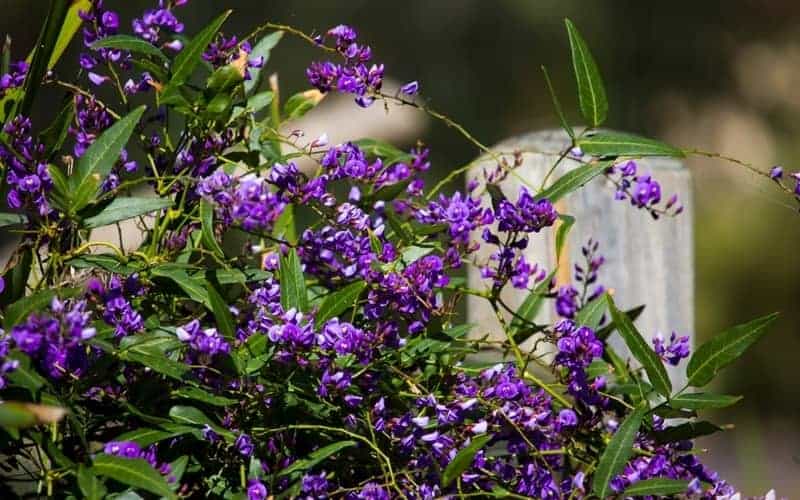
Height: Depends on pruning
Flowering: Typically winter to spring
Tolerance: Drought, mild frost, poor soils
This is another climbing plant that can ramble or sprawl across the ground!
Hardenbergia violacea is a popular fast-growing climbing plant, but some cultivars are prostrate, meaning they grow close to the ground. ‘Sea of Purple’ and ‘Happy Wanderer’ are two good options for ground cover.
When purchasing Hardenbergias, opt for cultivars suitable for your local climate. Prune after flowering to keep them from getting unruly.
Mat rush
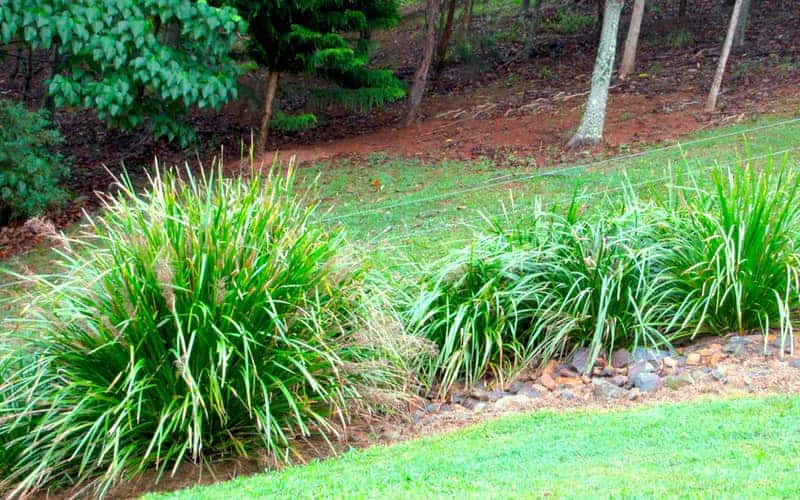
Height: Up to 1.0m
Flowering: Winter to spring
Tolerance: Cold, drought, mild frost, part shade, poor soils, salt
If you need an Australian native ground cover for shade, choose mat rush (Lomandra longifolia)!
This tough grass tolerates a wide range of conditions, even dry, shady areas. It’s perfect for filling in spaces under large trees or garden structures.
Native lomandra is excellent for controlling weeds and erosion, thanks to its fast-growing nature and deep roots. In spring, it puts out sweet-smelling, pale cream flowers.
Mow mat rush in late winter or early spring, before the growing season.
Native violet
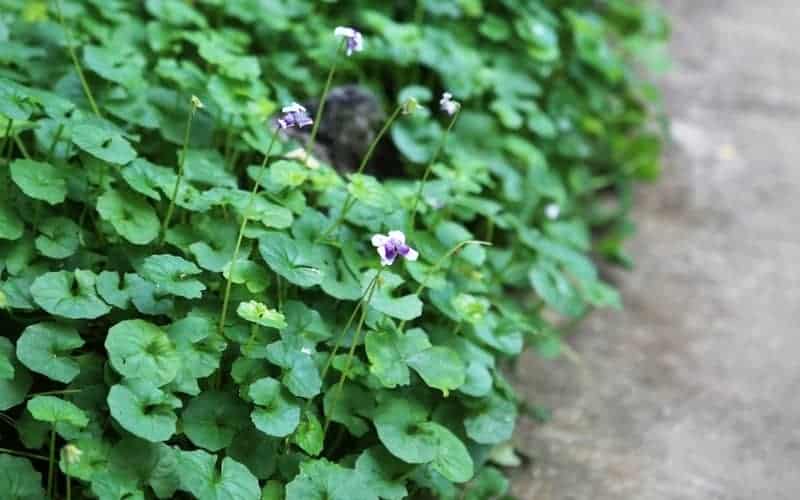
Height: Up to 0.4m
Flowering: Year-round
Tolerance: Cold, shade, poor soils, salt
Get colour no matter the season with native violet ground cover! Viola banksii is a well-loved native flowering plant, with purple-and-white blooms that emerge throughout the year.
Keep in mind, though — V. banksii is best as a native lawn substitute in low-traffic areas. Too much foot traffic can cause the plant to die back.
Native violet thrives most in part to full shade, as direct sunlight can make the foliage less lush. It may need additional watering during hot, dry weather.
NOTE: Be sure to get V. banksii plants, as other Viola varieties (such as V. hederacea) may be invasive outside their native regions.
Pig face
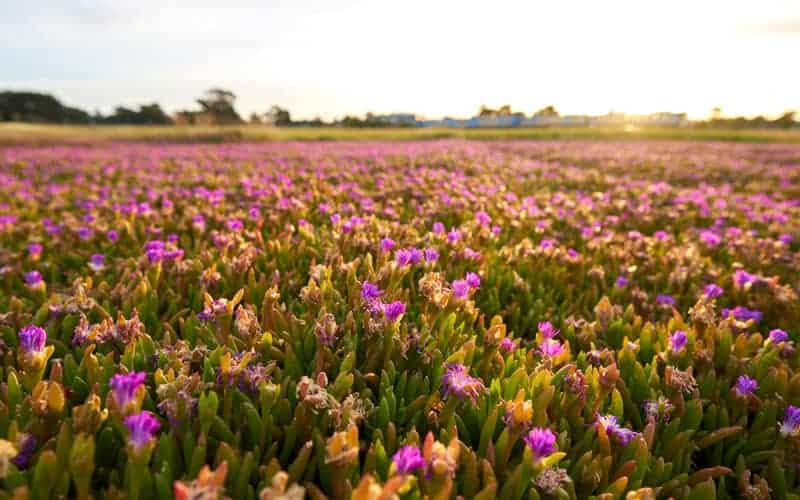
Height: Up to 0.2m
Flowering: Spring and summer
Tolerance: Drought, salt, moderate humidity, mild frost
From chunky leaves to bright pink flowers, what’s not to love about the native pig face?
Australia’s Carpobrotus succulents are excellent ground cover plants, with their creeping habit and strong root systems. They have no spikes or thorns, so they’re child-friendly, too!
Moreover, pig face is a practical plant to grow — the leaf juices can soothe mild burns (like aloe), and both the leaves and fruits are edible.
Native pig face can tolerate most conditions except very wet or humid climates, as they’re susceptible to root rot. The leaves are also vulnerable to cottony scale thanks to the dense growth habit.
Tips for Maintaining Native Ground Cover
Choose ground cover plants that are most suited to your local climate and environment. While native plants are adaptable, they’ll thrive most in conditions close to their wild habitat.
Additionally, check that your chosen plant isn’t considered invasive or weedy in your state.
Remember that low-maintenance doesn’t mean no maintenance! Native grasses, for example, may need some pruning so they don’t become unruly or unkempt.
Other plants, like native violets, need supplemental watering in periods of prolonged heat or drought.
And if you need help establishing ground cover plants — or keeping them healthy — go ahead and consult an expert local gardener! They can get your garden set up and handle the maintenance from the ground up.

